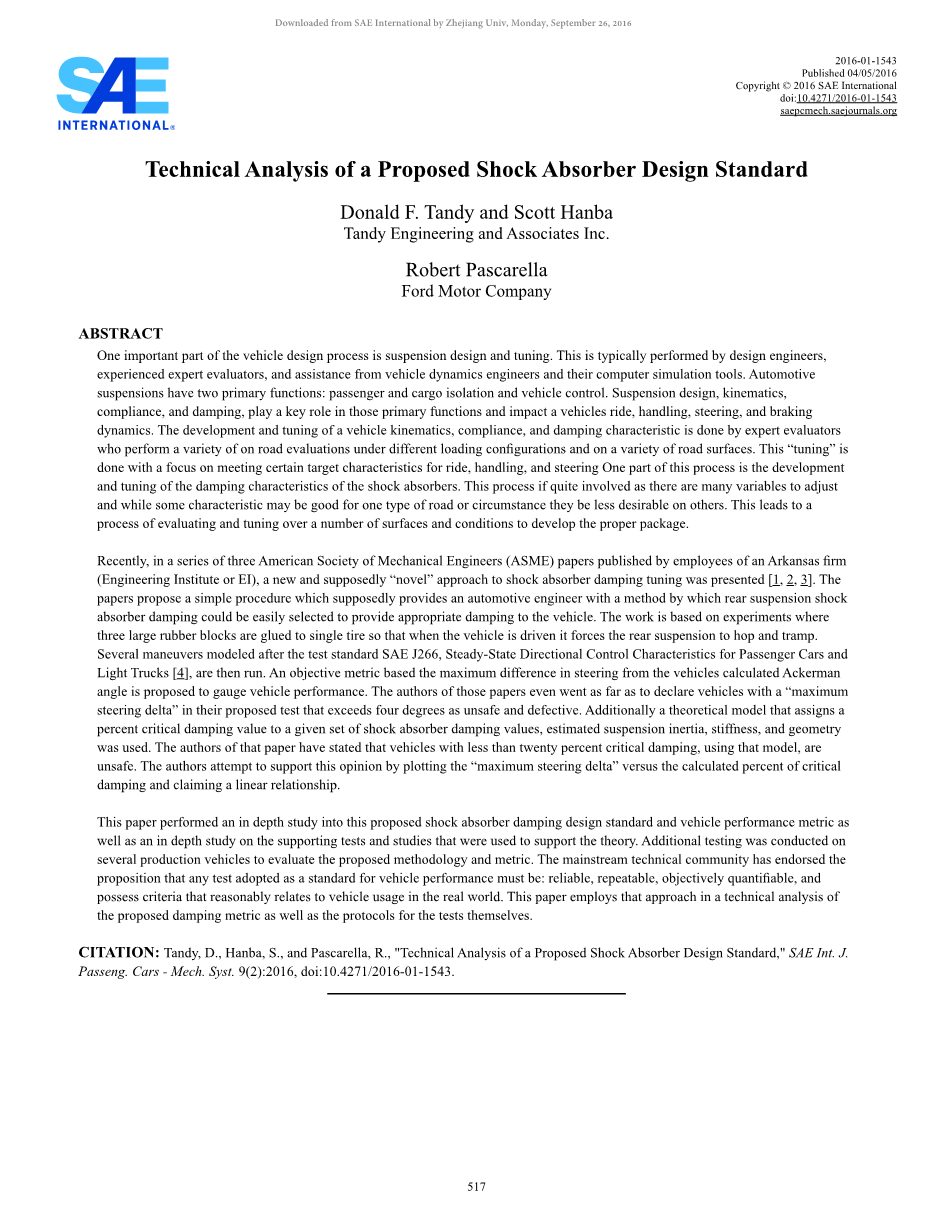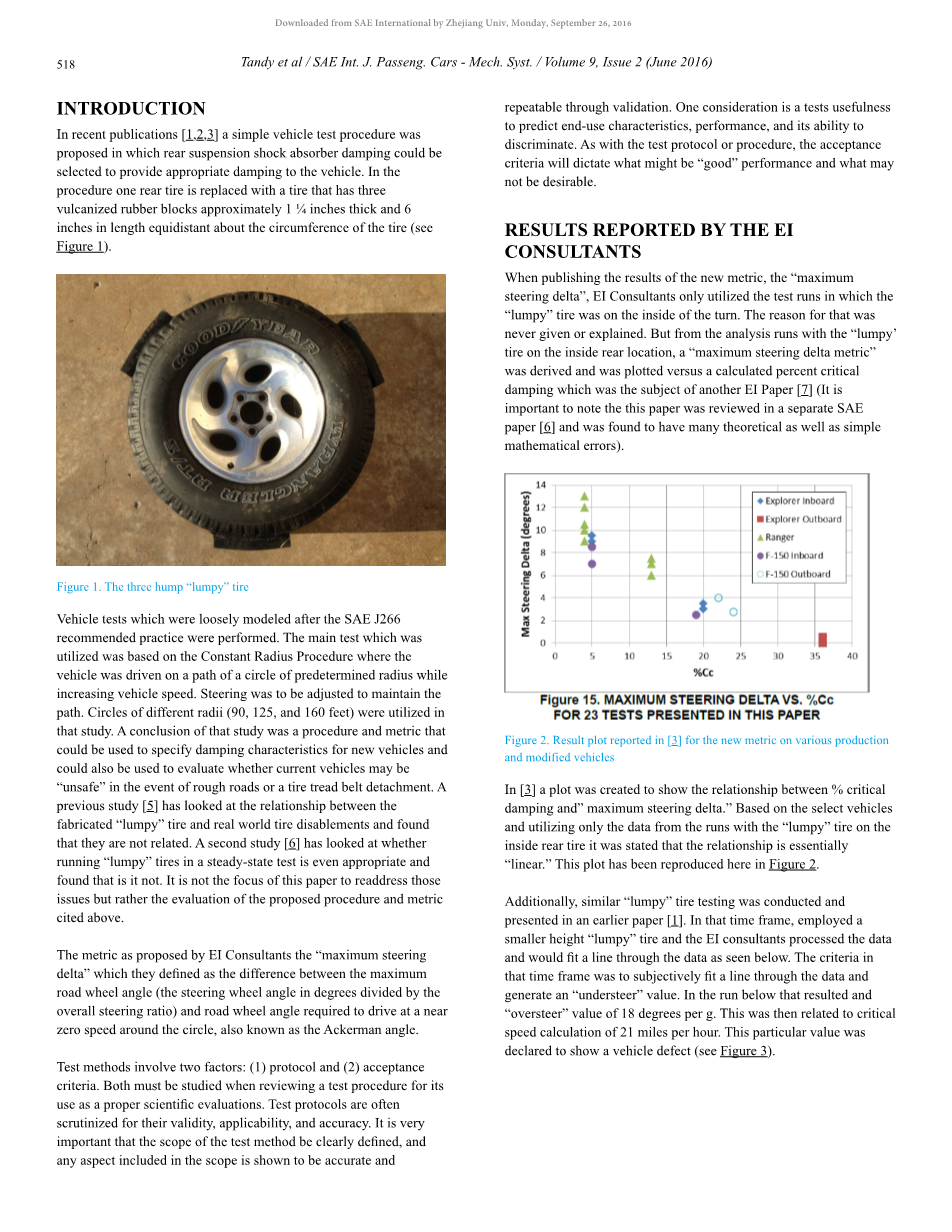

英语原文共 12 页,剩余内容已隐藏,支付完成后下载完整资料
摘 要
车辆设计过程中的一个重要部分是悬架设计和调整。这通常由设计工程师、经验丰富的专家评估员以及车辆动力学工程师及其计算机仿真工具的协助来完成。汽车悬架有两个主要功能:乘客和货物隔离和车辆控制。悬架设计、运动学、柔顺性和阻尼在这些主要功能中起着关键作用,并影响车辆的行驶、操纵、转向和制动动力学。车辆运动学、柔顺性和阻尼特性的开发和调整由专家评估员完成,他们在不同的加载配置和不同的路面上执行各种道路评估。这一“调整”的重点是满足行驶、操控和转向的某些目标特性这一过程的一部分是开发和调整减震器的阻尼特性。这一过程如果相当复杂,因为有许多变量需要调整,虽然某些特性可能对一种道路或环境有好处,但对其他道路或环境却不太理想。这将导致一个评估和调整多个曲面和条件的过程,以开发适当的开发包。
最近,在阿肯色州一家公司(工程学院或EI)的员工发表的三篇美国机械工程师学会(ASME)论文中,提出了一种新的、被认为是“新颖的”减震器阻尼调谐方法[1,2,3]。本文提出了一个简单的程序,为汽车工程师提供了一种后悬架减振器阻尼的选择方法。
这项工作是基于三个大橡胶块粘在单个轮胎上的实验,这样当车辆行驶时,它会迫使后悬架跳跃和践踏。然后,按照试验标准SAE J266(客车和轻型卡车的稳态方向控制特性)进行几次机动测试[4]。提出了一种基于车辆阿克曼角计算的最大转向差的客观度量方法来衡量车辆性能。这些论文的作者甚至宣称,在他们提出的超过四度的测试中,“最大转向三角洲”的车辆是不安全的和有缺陷的。此外,还使用了一个理论模型,该模型为给定的一组减震器阻尼值、估计的悬架惯性、刚度和几何结构指定了一个临界阻尼百分比。这篇论文的作者指出,使用该模型,临界阻尼小于20%的车辆是不安全的。作者试图通过绘制“最大转向增量”与所计算的临界阻尼百分比并支持线性关系来支持这一观点。
本文对所提出的减振器阻尼设计标准和车辆性能指标进行了深入的研究,并对支撑试验和理论研究进行了深入的研究。对几辆生产车辆进行了额外测试,以评估拟议的方法和指标。主流技术界赞同这样一种观点,即作为车辆性能标准采用的任何测试都必须:可靠、可重复、客观可量化,并拥有与现实世界中车辆使用合理相关的标准。本文将这种方法应用于对所提出的阻尼指标以及试验协议本身的技术分析。
Abstract
One important part of the vehicle design process is suspension design and tuning. This is typically performed by design engineers, experienced expert evaluators, and assistance from vehicle dynamics engineers and their computer simulation tools. Automotive suspensions have two primary functions: passenger and cargo isolation and vehicle control. Suspension design, kinematics, compliance, and damping, play a key role in those primary functions and impact a vehicles ride, handling, steering, and braking dynamics. The development and tuning of a vehicle kinematics, compliance, and damping characteristic is done by expert evaluators who perform a variety of on road evaluations under different loading configurations and on a variety of road surfaces. This “tuning” is done with a focus on meeting certain target characteristics for ride, handling, and steering One part of this process is the development and tuning of the damping characteristics of the shock absorbers. This process if quite involved as there are many variables to adjust and while some characteristic may be good for one type of road or circumstance they be less desirable on others. This leads to a process of evaluating and tuning over a number of surfaces and conditions to develop the proper package.
Recently, in a series of three American Society of Mechanical Engineers (ASME) papers published by employees of an Arkansas firm (Engineering Institute or EI), a new and supposedly “novel” approach to shock absorber damping tuning was presented [1, 2, 3]. The papers propose a simple procedure which supposedly provides an automotive engineer with a method by which rear suspension shock absorber damping could be easily selected to provide appropriate damping to the vehicle. The work is based on experiments where three large rubber blocks are glued to single tire so that when the vehicle is driven it forces the rear suspension to hop and tramp. Several maneuvers modeled after the test standard SAE J266, Steady-State Directional Control Characteristics for Passenger Cars and Light Trucks [4], are then run. An objective metric based the maximum difference in steering from the vehicles calculated Ackerman angle is proposed to gauge vehicle performance. The authors of those papers even went as far as to declare vehicles with a “maximum steering delta” in their proposed test that exceeds four degrees as unsafe and defective. Additionally a theoretical model that assigns a percent critical damping value to a given set of shock absorber damping values, estimated suspension inertia, stiffness, and geometry was used. The authors of that paper have stated that vehicles with less than twenty percent critical damping, using that model, are unsafe. The authors attempt to support this opinion by plotting the “maximum steering delta” versus the calculated percent of critical damping and claiming a linear relationship.
This paper performed an in depth study into this proposed shock absorber damping design standard and vehicle performance metric as well as an in depth study on the supporting tests and studies that were used to support the theory. Additional testing was conducted on several production vehicles to evaluate the proposed methodology and metric. The mainstream technical community has endorsed the proposition that any test adopted as a standard for vehicle performance must be: reliable, repeatable, objectively quantifiable, and possess criteria that reasonably relates to vehicle usage in the real world. This paper employs that approach in a technical analysis of the proposed damping metric as well as the protocols for the tests themselves.
目 录
第1章 引言 1
第5章 为什么有三个驼峰? 12
第6章 总结/结论 14
参考文献 15
附录 16
第1章 引言
在最近的文献[1,2,3]中提出了一个简单的车辆试验程序,其中可以选择后悬架减震器阻尼来为车辆提供适当的阻尼。在该过程中,一个后轮轮胎被一个轮胎替换,该轮胎有大约三英寸厚的硫化橡胶块和大约6英寸长的轮胎的圆周等距(见图1)。
图1 三峰“笨重”轮胎
按照SAE J266推荐规程进行了松散建模的车辆试验。使用的主要试验是基于恒定半径程序,即车辆在预定半径的圆上行驶,同时提高车速。必须调整转向以保持路径。研究中使用了不同半径(90、125和160英尺)的圆圈。这项研究的结论是一个程序和度量标准,可用于指定新车的阻尼特性,也可用于评估当前车辆在道路崎岖或轮胎胎面花纹带脱落的情况下是否“不安全”。先前的一项研究[5]研究了人造“块状”轮胎与现实世界中的轮胎缺陷之间的关系,发现它们没有关系。第二项研究[6]研究了在稳态试验中运行“块状”轮胎是否合适,发现事实并非如此。本文的重点不是重新审视这些问题,而是对上述拟议程序和指标的评估。
由EI咨询公司提出的“最大转向增量”的度量,它们定义为最大的车轮角度(在方向盘上的角度除以总转向比)和以接近零的速度在圆周附近行驶所需的车轮角度,也称为阿克曼角。
测试方法包括两个因素:(1)协议和(2)验收标准。在审查一个测试程序以作为适当的科学评估时,必须对这两种方法进行研究。测试协议的有效性、适用性和准确性经常受到审查。明确定义测试方法的范围是非常重要的,范围中包含的任何方面都通过验证证明是准确和可重复的。其中一个考虑因素是测试对预测最终用途特性、性能及其辨别能力的有用性。与测试协议或程序一样,验收标准将规定哪些性能可能“良好”,哪
剩余内容已隐藏,支付完成后下载完整资料
资料编号:[239006],资料为PDF文档或Word文档,PDF文档可免费转换为Word


